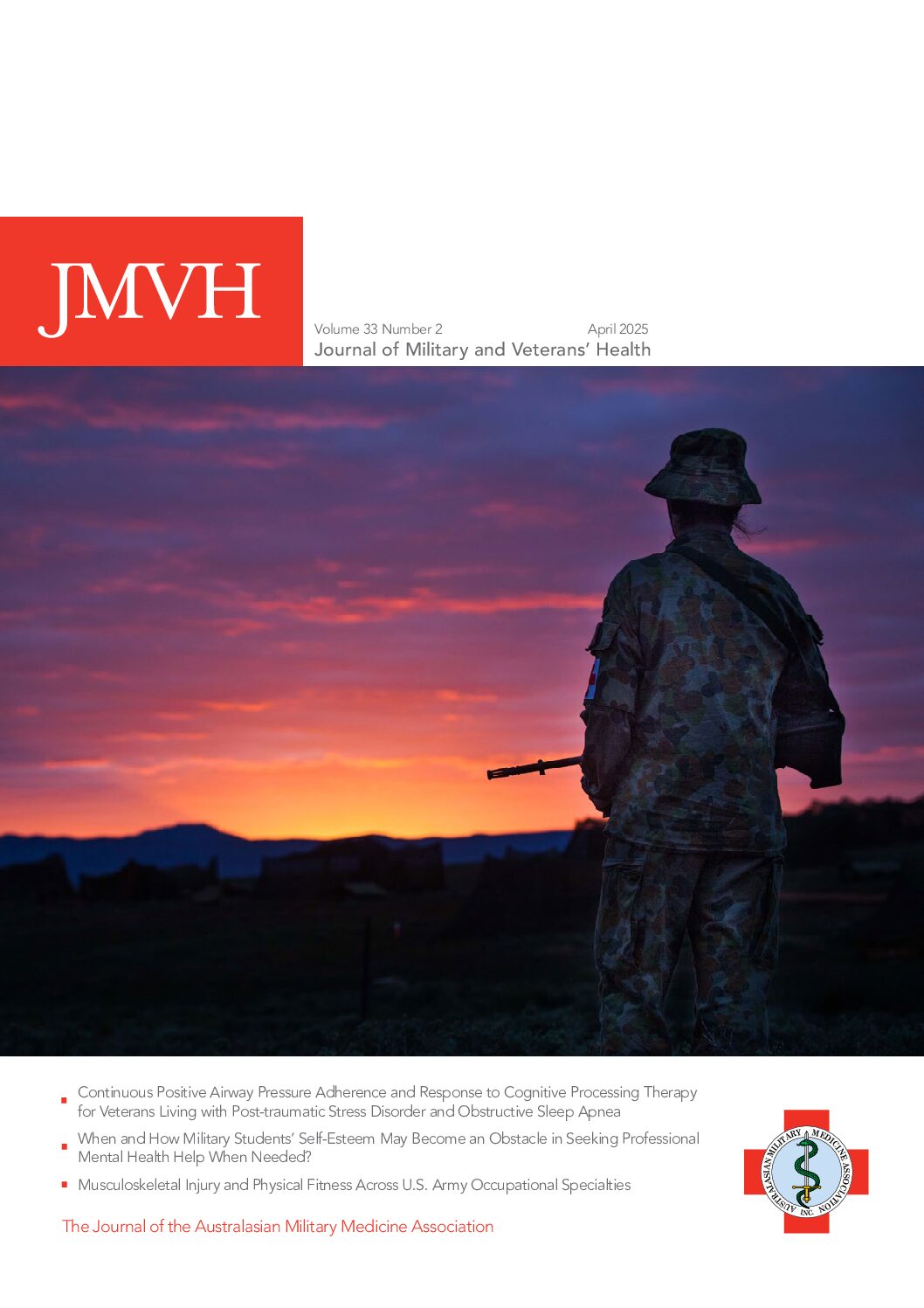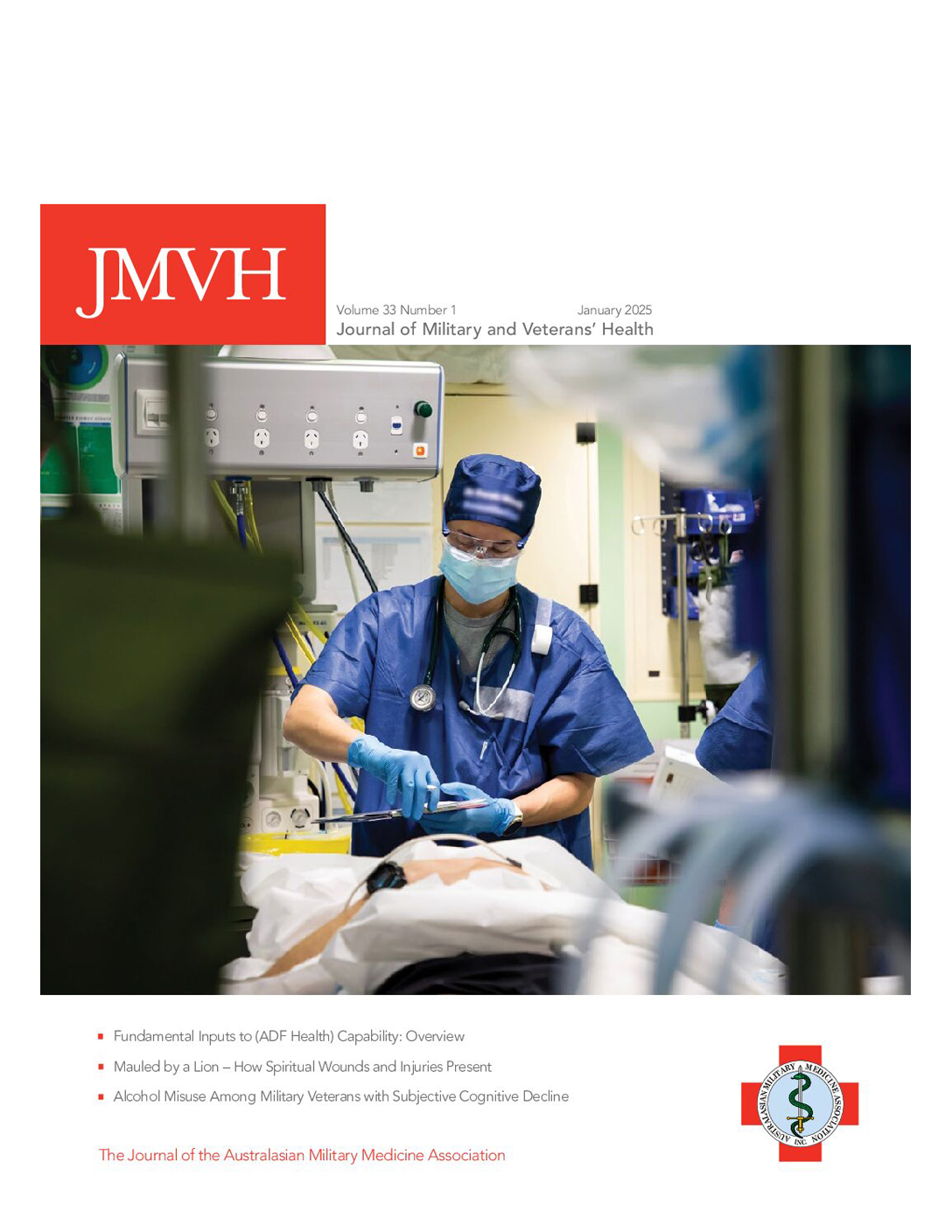Alcohol Misuse Among Military Veterans with Subjective Cognitive Decline
Abstract Although binge drinking has been identified as a significant risk factor for the development of cognitive decline, much less attention has been paid to binge drinking among patients already experiencing cognitive decline. Given that military veterans in the general population are more likely to engage in unhealthy alcohol consumption, we hypothesised that veteran–nonveteran disparities… Read more »
Acute Schistosomiasis: The ‘Fluke’ That Saved Taiwan
Abstract Acute schistosomiasis is rarely of military concern, but epidemics have disrupted tropical operations. Acute schistosomiasis is particularly challenging to diagnose because it presents as a non-specific febrile disease, often with an urticarial rash before parasites appear in the stool. US Army combat engineers were infected during bridge construction on Leyte in the invasion of… Read more »
General and Specific Benefits from the ADF ARRTS Program
Abstract The present study was part of an evaluation of the Arts for Recovery, Resilience, Teamwork and Skills (ARRTS) program conducted by the Australian Defence Force (ADF) for wounded, injured and ill veterans as an adjunct to their established treatments. Two previous evaluations, one using categorical judgments and one using standardised rating scales, yielded evidence… Read more »
An Operational Clinical Skill Set for the ADF General Surgeon: a proposal and proof of concept
Background Hippocrates recognised that civilian practice alone does not prepare military surgeons for the trauma they may treat while deployed. Similarly, many medical professionals acknowledge that the technical and non-technical skills required of military General Surgeons are unique to the combat environment. Civilian general surgery practice is increasingly characterised by subspecialisation and minimally invasive operative… Read more »
Malaria Determined Military Outcomes in Burma (Myanmar) Across Three Centuries
Abstract Disease has often determined the outcome of tropical military campaigns. This is especially true in Burma (Myanmar), where entire armies have been incapacitated by fever thought to be due to malaria during the Sino-Burmese Wars (1765–1769), the Anglo-Burmese Wars (especially the first in 1824–1826) and World War II (1942–1945) when the British 14th Army… Read more »
Self-reported Liver Disorders in Australian Vietnam War Veterans
H Wang, X Liang, K Bridle, D Crawford Abstract Background: Self-reported physical comorbidities are common among combat veterans. Until now, it has been unclear what underlying risk factors were associated with these self-reported health disorders. Purpose: This study aimed to compare self-reporting and objective clinical investigations of liver disorders in a large group of Australian… Read more »
Cause-Specific Mortality Risks Through 2016, Among U.S. Veterans of the Southwest Asia Theater
T Bullman, A Schneiderman Introduction Much of the research on the post-deployment mortality of veterans who deployed as part of Operations Enduring Freedom, Iraqi Freedom and New Dawn (OEF/OIF/OND) has focused on the risk of suicide among returning veterans.1-2 To date, mortality studies of OEF/OIF/OND veterans have not included analysis of specific disease-related mortality. While… Read more »
Acute Respiratory Epidemics in Australian Military Forces 1940
G. D Shanks, N Marsh Abstract Acute respiratory infections due to a variety of viral pathogens can incapacitate entire military units. During World War II, recruit camp epidemics of respiratory infections at Woodside Camp South Australia and Puckapunyal Victoria caused considerable morbidity with up to 44% attack rates but little if any mortality. Camp hospitals… Read more »
Disparities in Cigarette Use and Heavy Episodic Drinking Among Older Veterans and Nonveterans
J McDaniel, D Albright, M Torabi Abstract Background: Little assessment data on cigarette use (CU) and heavy episodic drinking (HED) among older military veterans is available for local health education program planning. Purpose: The purpose of this study was to estimate the prevalence of CU and HED among older veterans and nonveterans at the local… Read more »
Measles Mortality in the Armies of the Early 20th Century
G. D Shanks Abstract Measles remained a lethal infection during the early 20th century within the military but mortality disappeared prior to immunisation 50 years later. Historical records were reviewed to understand this transition. Measles mortality in soldiers was largely (>80%) due to secondary bacterial pneumonia but this could be highly seasonal, as seen in… Read more »
Plasmodium knowlesi infection in an Australian soldier following jungle warfare training in Malaysia
Abstract: An Australian Army soldier developed a fever after returning to Australia following a three-month deployment to Rifle Company Butterworth, Malaysia. Ten days prior to presentation he had participated in jungle warfare training at Burma Camp, Pulada in Johor, Malaysia. No known direct contact was made with monkeys, which were known to be in the… Read more »
Comparison of Two Co-Located Infantry Battalions during the 1918 Influenza Pandemic with Very Different Mortality Experiences
D Shanks, M Waller Abstract The 1918–1919 influenza pandemic was the greatest mortality event in recent history whose specific origins and mechanism remain largely unexplained. Wide ranges of mortality were observed in otherwise identical groups for unclear reasons. The 49th (n=1363) and 50th (n=1243) Battalions (BN) of the Australian Imperial Force (AIF) respectively had one… Read more »
Veterans’ attitudes towards discussing sexual practices and sexual orientation with therapists
M Vendlinski, G Simons, J Yen, S Larsen Abstract Background: It is widely recommended that sexuality be discussed during health-care assessments and treatment. Health-care providers often do not raise the topic of sexuality, even though patients typically welcome these conversations. Purpose: The current study examines whether veterans report having discussions about sexuality with their psychotherapists…. Read more »
Examining Moral Injury Awareness in a Clinical Setting
M Kopacz, G L Charpeid, L A Hollenbeck, J Lockman Abstract Moral injury is a relatively novel clinical construct recognized as a focus of concern in some military veteran populations. This short communication presents findings from a descriptive survey examining awareness of moral injury in a clinical setting specialized in veteran health services and treatment…. Read more »
Psychological Development of Emerging Adults in the Military and transition to the civilian workforce
C C Hicks, E Bell, D Gray This paper considers the unique role that serving in the Australian Army may have on shaping the psychological development of emerging adults. Emerging adulthood is defined as the development period from the late teens through the twenties, with a focus on ages 18-25. For most young people in… Read more »
Risk of Suicide Among Veterans with Traumatic Brain Injury Experiencing Homelessness
B. Palladino, A. E. Montgomery, M. Sommers, J. D. Fargo Introduction Suicide is the tenth leading cause of death in the United States; during 2013 more than 41,000 individuals died as a result of self-inflicted injury, a rate of 13 suicide deaths per 100,000 individuals1. The rate of suicide among the 22 million veterans in 2013 was almost three… Read more »
Malaria Outbreak Aboard an Australian Navy Ship in the Indian Ocean
G. C. Rose,1 N. Westphalen,2 G. D. Shanks3 Abstract: Four sailors aboard HMAS Newcastle were infected with falciparum malaria during a port visit to Dar-es-Salaam in Tanzania. All four were successfully treated at sea with oral atovaquone/proguanil. Besides their apparent non-adherence with the usual antimalarial precautions, the key aspects of this outbreak include a lack… Read more »
PROJECT CEREBRO: An Evaluation of Blast Gauges in the Australian Defence Force
BACKGROUND Blast-related Traumatic Brain Injury (TBI) has been a frequent and prominent wound in recent conflicts. Helmet sensors or blast gauges have been proposed to monitor blast effects in troops exposed to Improvised Explosive Devices (IED). PURPOSE The findings of a trial of blast gauges in Australian troops deployed in Afghanistan are described. MATERIALS AND… Read more »
Changes to the landscape of GP training, but some aspects stay the same. Should we expect further delays to medical officer training progression?
Abstract: ADF medical officers must complete military, military health and civilian GP training to progress to the independently deployable status of Medical Level 3. (ML3). Changes to administration of the Australian General Practice Training program (AGPT) is making recruitment more challenging for medical officers. Budget changes have removed the prevocational GP placement program that supported… Read more »
Rabies post-exposure prophylaxis in Australian Defence Force personnel in Afghanistan
Abstract Background: Australian Defence Force (ADF) personnel have been deployed to Afghanistan since 2002. The 2011 death of a US Army soldier from rabies raised the awareness of rabies in ADF personnel deployed in Afghanistan. Purpose: The study aims to review rabies exposure in ADF personnel supported by the Australian Role 1 health facility in… Read more »






